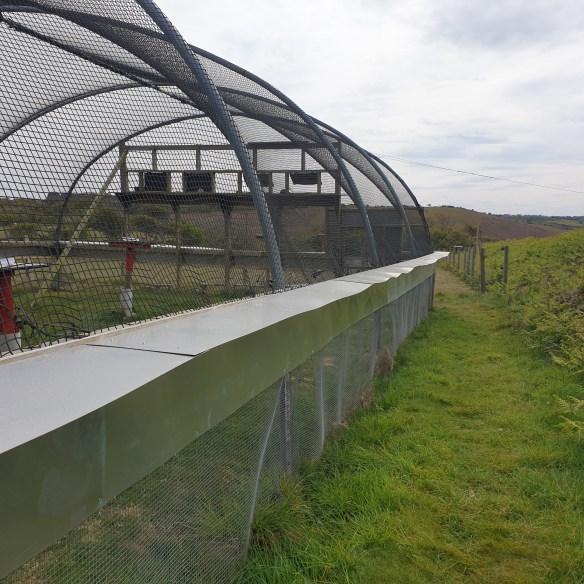By Liz Corry
Sun, Sorel, and sweaty volunteers
At the start of September, a group of Durrell volunteers responded to the call for help at Sorel to remove bracken alongside the aviary and patch up holes in the netting.
The weather was less forgiving than anticipated with soaring temperatures and no shade other than the shadow of the choughs occasionally flying overhead. Fuelled by caffeine, cold water, and chocolate digestives they managed to finish the tasks in time for the choughs’ supplemental feed.
The only real challenge that day was working out how many bags of bracken can fit in the back of a Dacia. Spoiler alert – its two. Which meant two trips to the burn pile at the Zoo as we had managed to fill four bags clearing the one tiny strip.
Having the holes in the netting closed up will allow us to start catching up choughs again to replace leg rings. We still have one youngster in need of a metal ring.
To catch a chough in the aviary first requires the chough to enter the aviary. Something the Jersey birds decided they didn’t want to do this month. At least not in front of staff.
Preliminary study
We are hoping to setup a postgraduate research project next year that investigates the choughs’ use of the supplemental feed site with the help of RFID technology. From bank cards to cat flaps, the day-to-day use of chip reading technology is increasingly being applied to wildlife conservation and research.
We can potentially use the technology to tell us which birds are visiting the aviary, how often, for how long and what times of day, the list goes on. There is even the possibility of remotely weighing individuals and calculating how much food they take on, on an individual and group basis. The challenge is designing a setup suitable for choughs, their behaviour, and their environment. A perfect puzzle for a post-grad.
In the meantime, we are kick starting the study by finding out what size and shape antennae we could use to read the RFID chips attached to the birds as a leg ring. An off-the-shelf bird counter is available using a square antennae. Will a chough happily walk through this?
Instead of spending £800 up front to find out the answer is no, we are going to play around with hatch sizes at the aviary. They already pass through a 40cm by 60cm rectangle. Can they cope with 25cm by 25cm?
This means we need to spend lots of time watching, recording, and trawling through camera trap footage. It’s actually more entertaining than it sounds.
WildSnap! at Sorel
Speaking of camera trap footage…Durrell launched a nature connections programme in summer called WildSnap aimed at teenagers and their tech savvy brains. In partnership with My Naturewatch using a combination of Raspberry Pi electronics and Blue Peter magic, you build your own camera trap then go out and see what wildlife you can find.
The kit costs roughly the same price as a cheap bog-standard camera trap you can buy from the site that rhymes with Glamazon (especially if you live in a VAT-free country). Naturally we were keen to put one to the test and see how useful it could be on the chough project.
Image quality is equal if not better than a budget priced shop-bought camera. The design might not be the most robust, but it does the job taking video or photo.
For any non-teens who want to try building their own camera, check out the how to video below. Raspberry Pi products are widely available these days. Just remember to drop the ‘e’ when Googling!
Chough travels
Whilst staff attention focused on the aviary, the choughs decided September was best spent away from Sorel. Once again, Les Landes to Plémont became a popular playground as well as food source.
There were several consistent reports of choughs in the south west of the Island too. Enough to suggest a small group had made the visit their daily morning routine.
One colleague reported her delight in seeing the birds outside her window whilst staying at the Corbière radio tower. Quite an impressive view made even more memorable by the charismatic choughs.
Not so many reports from east of Sorel. It’s unclear if the parish of Trinity still has a resident chough or two. We are entering the time of year when choughs tend to disperse further afield. Residents in the other Channel Islands and the French coast should start keeping their eyes peeled!















































































